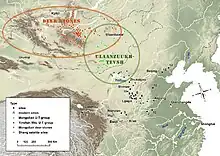 | |
| Geographical range | Mongolia |
|---|---|
| Period | Bronze Age, Iron Age |
| Dates | 1450–1000 BC[1] |
| Preceded by | Ancient Northeast Asians |
| Followed by | Slab Grave culture |
The Ulaanzuukh culture, also Ulaanzuukh-Tevsh culture (Ch:乌兰朱和文化, c. 1450-1000 BCE),[1] is an archaeological culture of the Late Bronze Age eastern Mongolia. It likely preceded and was the origin of the Slab-grave culture.[2]
Genetic profile

The genetic profile of individuals belonging to this culture is virtually identical to the profile the Slab Grave culture individuals,[4] which is consistent with the hypothesis that the Slab Grave culture emerged from the Ulaanzuukh.[4] Genetically, the populations of the Ulaanzuukh culture were rather homogeneous, and part of the Ancient Northeast Asians (ANA).[5][6] In a recent study, they have been shown to have a purely Northeast Asian profile (nearly 100% ANA), with one outlier having a western Altai_MLBA profile.[3] The Ulaanzuukh culture was genetically distinct from the Deer stone culture, located in western and northern Mongolia.[3]
The Ulaanzuukh and Slab Grave culture individuals cluster closely together and are collectively referred to as the "Ulaanzuukh_SlabGrave genetic cluster".[5][6]
Influences
.png.webp)

The Ulaanzuukh culture may have contributed to transfer to Shang dynasty China of the chariot and weapon technologies and designs which originated with the Deer stones culture of the Mongolian plateau.[8] Daggers found in Ulaanzuukh graves have broadly similar designs to those of the Deer stones culture, with curved blades and pommels decorated with the heads of animals or with "jingles", which are key design elements adopted by the Shang dynasty for their weaponery.[9]
References
- 1 2 Honeychurch, William (2015). Inner Asia and the Spatial Politics of Empire: Archaeology, Mobility, and Culture Contact (PDF). p. 112. doi:10.1007/978-1-4939-1815-7.
- ↑ Lee 2023, "“SlabGrave” was representative of people in eastern and central Mongolia associated with Slab Grave (ca. 1000 to 300 BCE) mortuary sites. Likely arising out of the LBA Ulaanzuukh archaeological culture (ca. 1450 to 1150 BCE) in eastern Mongolia, Slab Grave groups expanded into central and northern Mongolia as far north as the Lake Baikal region. Overall, individuals from the Ulaanzuukh and the Slab Grave cultures present a homogeneous genetic profile that has deep roots in the region and is referred to as Ancient Northeast Asian (ANA). The recent publication of additional genome-wide data for Ulaanzuukh and Slab Grave individuals provided an opportunity to investigate the genetic profile of the Slab Grave individuals across a wider geographical distribution (Fig. 1A) and to refine our genetic modeling of the formation of the Xiongnu more generally. We updated our admixture modeling of Ulaanzuukh and Slab Grave individuals using the qpAdm program.".
- 1 2 3 Jeong et al. 2020, p. Figure 3C, 4A.
- 1 2 Jeong, Choongwon; Wang, Ke; Wilkin, Shevan; Treal Taylor, William Timothy. "A Dynamic 6,000-Year Genetic History of Eurasia's Eastern Steppe". Cell.
- 1 2 Lee 2023.
- 1 2 Rawson 2020.
Sources
- Jeong, Choongwon; Wang, Ke; Wilkin, Shevan; Taylor, William Timothy Treal; Miller, Bryan K.; Bemmann, Jan H.; Stahl, Raphaela; Chiovelli, Chelsea; Knolle, Florian; Ulziibayar, Sodnom; Khatanbaatar, Dorjpurev; Erdenebaatar, Diimaajav; Erdenebat, Ulambayar; Ochir, Ayudai; Ankhsanaa, Ganbold; Vanchigdash, Chuluunkhuu; Ochir, Battuga; Munkhbayar, Chuluunbat; Tumen, Dashzeveg; Kovalev, Alexey; Kradin, Nikolay; Bazarov, Bilikto A.; Miyagashev, Denis A.; Konovalov, Prokopiy B.; Zhambaltarova, Elena; Miller, Alicia Ventresca; Haak, Wolfgang; Schiffels, Stephan; Krause, Johannes; Boivin, Nicole; Erdene, Myagmar; Hendy, Jessica; Warinner, Christina (12 November 2020). "A Dynamic 6,000-Year Genetic History of Eurasia's Eastern Steppe". Cell. 183 (4): 890–904.e29. doi:10.1016/j.cell.2020.10.015. hdl:21.11116/0000-0007-77BF-D. ISSN 0092-8674.
- Lee, Juhyeon (14 April 2023). "Genetic population structure of the Xiongnu Empire at imperial and local scales". Science Advances. 9 (15): eadf3904. doi:10.1126/sciadv.adf3904. ISSN 2375-2548. PMC 10104459.
- Rawson, Jessica (June 2020). "Chariotry and Prone Burials: Reassessing Late Shang China's Relationship with Its Northern Neighbours". Journal of World Prehistory. 33 (2): 135–168. doi:10.1007/s10963-020-09142-4.